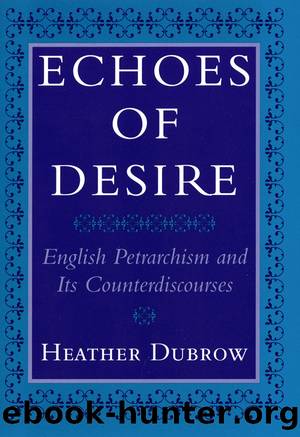Echoes of Desire by Heather Dubrow

Author:Heather Dubrow
Language: eng
Format: epub
Publisher: CORNELL UNIVERSITY PRESS
Published: 2018-01-09T00:00:00+00:00
* * *
1Hall is quoted from Arnold Davenport, ed., The Collected Poems of Joseph Hall (Liverpool: Liverpool University Press, 1949).
2All citations from Sidney are to William A. Ringler Jr., ed., The Poems of Sir Philip Sidney (Oxford: Clarendon, 1962).
3See, e.g., James J. Scanlon, âSidneyâs Astrophil and Stella: âSee what it is to Loveâ Sensually!â SEL, 16 (1976), 65â74; and Andrew D. Weiner, âStructure and âFore Conceitâ in Astrophil and Stella,â TSLL, 16 (1974), 1â25.
4The most detailed presentation of this case appears in two studies by Thomas P. Roche Jr., âAstrophil and Stella: A Radical Reading,â in Sir Philip Sidney: An Anthology of Modem Criticism, ed. Dennis Kay (Oxford: Clarendon, 1987); and Petrarch and the English Sonnet Sequences (New York: AMS Press, 1989), chap. 4.
5See esp. Jacqueline T. Miller, ââLove doth hold my handâ: Writing and Wooing in the Sonnets of Sidney and Spenser,â ELH, 46 (1979), 541â558; and Maureen Quilligan, âSidney and His Queen,â in The Historical Renaissance: New Essays on Tudor and Stuart Literature and Culture, ed. Heather Dubrow and Richard Strier (Chicago: University of Chicago Press, 1988), esp. p. 189.
6Compare Marion Campbellâs assertion that the sequence as a whole creates yet frustrates our anticipation of closure (âUnending Desire: Sidneyâs Reinvention of Petrarchan Form in Astrophil and Stella,â in Sir Philip Sidney and the Interpretation of Renaissance Culture: The Poet in His Time and in Ours, ed. Gary F. Waller and Michael D. Moore [London and Totowa, N.J.: Croom Helm and Barnes and Noble, 1984], p. 92).
7OED, s.v. âpaint.â
8Patricia Fumerton argues from a different perspective that the poem undercuts its claim to present pure, unmediated feeling; she notes that the Muse speaks for Sidney in the final line (Cultural Aesthetics: Renaissance Literature and the Practice of Social Ornament [Chicago: University of Chicago Press, 1992], pp. 102â103).
9See, e.g., Ringler, Poems of Sir Philip Sidney, p. 459.
10Neil L. Rudenstine, Sidneyâs Poetic Development (Cambridge: Harvard University Press, 1967), p. 200.
11On Sidneyâs propensity for punning, see Alan Sinfield, âSexual Puns in âAstrophil and Stella,ââ EIC, 24 (1974), 341â355.
12On the controversial and vexed issue of the pronunciation of h, see Fausto Cercignani, Shakespeareâs Works and Elizabethan Pronunciation (Oxford: Clarendon, 1981), pp. 332â343.
13In The âInwardâ Language: Sonnets of Wyatt, Sidney, Shakespeare, Donne (Chicago: University of Chicago Press, 1983), chap. 4, Anne Ferry discusses Sidneyâs preoccupation with the heart from a different perspective, arguing that he and Shakespeare manifest a new preoccupation with the inability of language to express inner being.
14Compare Gary F. Wallerâs argument that both Petrarchism and Protestantism involve decentered selves (âThe Rewriting of Petrarch: Sidney and the Languages of Sixteenth-Century Poetry,â in Sidney and the Interpretation of Renaissance Culture, ed. Waller and Moore).
15On the echo of Wilson, see Russell M. Brown, âSidneyâs Astrophil and Stella, I,â Explicator, 32 (1973), item 21; and David Kalstone, Sidneyâs Poetry: Contexts and Interpretations (Cambridge: Harvard University Press, 1965), pp. 127â128. On familial references throughout the sequence, see Cristina Malcolmson, âPolitics and Psychoanalysis: Sidneyâs Imagery of the Child,â unpublished paper delivered at the 1990 Modem Language Association convention, Chicago.
Download
This site does not store any files on its server. We only index and link to content provided by other sites. Please contact the content providers to delete copyright contents if any and email us, we'll remove relevant links or contents immediately.
The Power of Myth by Joseph Campbell & Bill Moyers(1014)
Half Moon Bay by Jonathan Kellerman & Jesse Kellerman(954)
Inseparable by Emma Donoghue(937)
A Social History of the Media by Peter Burke & Peter Burke(936)
The Nets of Modernism: Henry James, Virginia Woolf, James Joyce, and Sigmund Freud by Maud Ellmann(836)
The Spike by Mark Humphries;(766)
The Complete Correspondence 1928-1940 by Theodor W. Adorno & Walter Benjamin(749)
A Theory of Narrative Drawing by Simon Grennan(742)
Culture by Terry Eagleton(724)
Ideology by Eagleton Terry;(696)
Bodies from the Library 3 by Tony Medawar(683)
World Philology by(678)
Farnsworth's Classical English Rhetoric by Ward Farnsworth(674)
Game of Thrones and Philosophy by William Irwin(671)
High Albania by M. Edith Durham(659)
Adam Smith by Jonathan Conlin(648)
A Reader’s Companion to J. D. Salinger’s The Catcher in the Rye by Peter Beidler(647)
Comic Genius: Portraits of Funny People by(616)
Monkey King by Wu Cheng'en(611)
